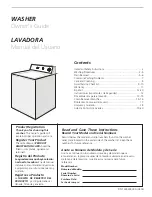
12.
SECIJRE WORK. Use clamps or a vice to hold work when
practical. It is safer than using your hand and it frees both hands
to operate tool.
13.
DON’T OVERREACH. Keep proper footing and balance at
all times.
14.
MAINTAIN TOOL WITH CARE. Keep tool sharp and clean for
best and safest performance. Follow instructions for lubrication
and changing accessories. Inspect tool cords periodically and if
damages have repaired by an authorized service facility. Inspect
extension cords periodically and replace if damaged. Keep
handles dry, clean and free from oil and grease.
15.
DISCONNECT TOOLS before servicing; when changing
accessories, such as blades, bits, cutters and the like.
16.
REMOVE ADJUSTING KEYS AND WRENCHES. Form
habit of checking to see that keys and adjusting wrenches are
removed from tool before turning it on.
17.
AVOID UNINTENTIONAL STARTING. Ensure switch is off
when plugging in.
18.
USE PROPER EXTENSION CORD. Make sure your
extension cord is in good condition. When using an extension
cord, be sure to use one heavy enough to carry the current your
product will draw. An undersize cord will cause a drop in line
Voltage resulting in loss of power and overheating. When tool is
used outdoors, use only extension cords intended for outdoor
use and so marked.
19.
ALWAYS KEEP ALERT. Do not let familiarity gained from
frequent use of your tool cause a careless mistake. Always
remember that a careless fraction of a second is sufficient to
inflict severe injury. Watch what you are doing: Use common
sense. Do not operate tool when you are tired.
20.
CHECK DAMAGED PARTS. Before further use of the
tool, a guard or other part that is damaged should be carefully
checked to determine that it will operate properly and perform
its intended function check for alignment of moving parts,
binding of moving parts, breakage of parts, mounting, and any
other conditions that may affect its operation. A guard or other
part that is damaged should be properly repaired and replaced.
by an authorized service centre. Unless otherwise indicated
in ~is instruction manual. Have defective switches replace by
authorized service centre. Do not use tool if switch does not
turn it on and off.
21.
USE RECOMMENDED ACCESSORIE5. Consult the
owner’s manual for recommended accessories. The use of
improper accessories may cause risk of injury to persons.
22.
HAVE YOUR TOOL REPAIRED BY A QUALIFIED PERSON.
This electric tool is in accordance with the relevant safety rules.
Repairs should only be carried out by qualified in considerable
danger to the user.
23.
SAVE THESE INSTRUCTlONS. Read these instructions and
save these instructions for operating guide.
24.
KEEP GUARDS IN PLACE, and in working order.
25.
NEVER STAND ON TOOL. Serious injury could occur if the
tool is tipped or it cuffing tool is unintentionally contacted.
26.
DIRECTION OF FEED. Feed work into a blade or cutter
against the direction of rotation of the blade or cutter only.
27.
NEVER LEAVE TOOL RUNNING UNATTENTED. TURN
POWER OFF. Don’t leave tool until it comes to a complete stop.
28.
THINK SAFETY. Safety is a combination of common sense
and alertness whenever the tool is in operation.
2
GENERAL SAFETY RULES FOR POWER TOOLS:




































